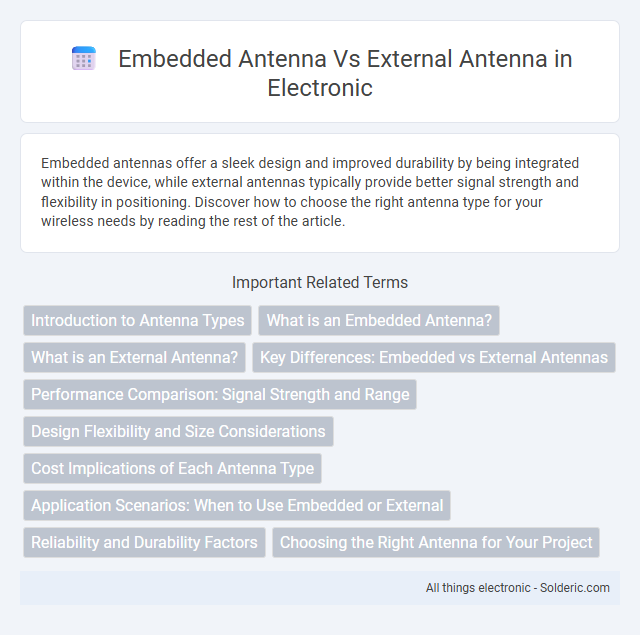Embedded antennas offer a sleek design and improved durability by being integrated within the device, while external antennas typically provide better signal strength and flexibility in positioning. Discover how to choose the right antenna type for your wireless needs by reading the rest of the article.
Comparison Table
| Feature | Embedded Antenna | External Antenna |
|---|---|---|
| Design | Integrated inside device | Attached externally |
| Size | Compact, saves space | Usually larger |
| Signal Strength | Moderate, limited by device housing | Stronger, adjustable position |
| Durability | Protected within device | Exposed to environmental damage |
| Installation | Pre-installed, no setup needed | Requires manual attachment |
| Flexibility | Fixed orientation | Swivel and positioning options |
| Cost | Lower manufacturing cost | Higher due to materials and design |
| Use Case | Compact devices, mobile phones, IoT | Routers, outdoor devices, performance critical |
Introduction to Antenna Types
Embedded antennas are integrated directly into a device's circuit board, offering compact size and protection from environmental factors, ideal for sleek, portable electronics. External antennas extend outside the device, providing enhanced signal range and flexibility for positioning, which is crucial in environments requiring stronger connectivity. Your choice between embedded and external antennas depends on device design constraints and signal performance needs.
What is an Embedded Antenna?
An embedded antenna is a compact, integrated antenna built directly into a device's housing or circuit board, designed to optimize space and improve durability. Unlike external antennas, embedded antennas are hidden and protected from physical damage, making them ideal for sleek, modern electronics such as smartphones and IoT devices. Your choice between embedded and external antennas depends on factors like design constraints, signal performance, and environmental resilience.
What is an External Antenna?
An external antenna is a separate component connected to a device that transmits and receives radio frequency signals, often enhancing wireless communication range and signal strength. Unlike embedded antennas integrated within the device's casing, external antennas can be physically adjusted or replaced to optimize performance for specific environments. These antennas are commonly used in applications requiring stronger connectivity, such as routers, mobile hotspots, and industrial communication devices.
Key Differences: Embedded vs External Antennas
Embedded antennas are integrated within a device's casing, offering compact design and protection from physical damage but often with limited range and performance compared to external antennas. External antennas protrude from the device, providing superior signal strength and flexibility for positioning, which can enhance connectivity in challenging environments. Your choice depends on balancing device aesthetics and durability against the need for robust wireless communication.
Performance Comparison: Signal Strength and Range
External antennas generally provide superior signal strength and extended range compared to embedded antennas due to their larger size and ability to be positioned optimally for better reception. Embedded antennas, integrated within the device, offer a compact and aesthetic design but typically experience reduced performance in challenging environments with obstacles or interference. Signal range for external antennas can exceed several hundred meters, while embedded antennas often have a shorter effective range, making external options preferable for applications requiring robust connectivity.
Design Flexibility and Size Considerations
Embedded antennas offer greater design flexibility by integrating directly within the device, enabling compact and streamlined form factors essential for modern electronics like wearables and IoT devices. External antennas, while typically larger and protruding, can provide enhanced signal performance but impose limitations on device size and aesthetics. Prioritizing embedded antennas supports miniaturization and sleek designs, balancing space constraints with acceptable performance for many applications.
Cost Implications of Each Antenna Type
Embedded antennas generally reduce overall costs by eliminating the need for additional components and external casings, which simplifies manufacturing and assembly processes. External antennas tend to increase expenses due to separate parts, mounting hardware, and potential durability issues requiring more robust materials or design adjustments. Your choice between embedded and external antennas will impact both production budgets and long-term maintenance costs based on device application and volume.
Application Scenarios: When to Use Embedded or External
Embedded antennas are ideal for compact devices such as smartphones, wearables, and IoT sensors where space constraints and aesthetic integration are critical, offering reliable performance in close-range communications. External antennas are preferred in applications requiring enhanced signal strength and range, such as industrial equipment, vehicles, and outdoor communication systems, where environmental factors or obstacles demand flexible positioning. Choosing between embedded and external antennas depends on the device size, desired communication range, environmental conditions, and performance requirements specific to each use case.
Reliability and Durability Factors
Embedded antennas offer enhanced reliability and durability due to their protected internal placement, reducing exposure to environmental damage such as moisture, dust, and physical impact. External antennas, while often providing stronger signal performance, are more vulnerable to mechanical wear, weather conditions, and accidental damage, which can compromise their long-term functionality. Devices using embedded antennas benefit from fewer points of failure and improved resistance to harsh operating environments.
Choosing the Right Antenna for Your Project
Selecting the right antenna for your project depends on factors such as device size, range requirements, and environmental conditions. Embedded antennas offer compact integration and reduced assembly costs, making them ideal for sleek, space-constrained designs, while external antennas provide superior signal strength and flexibility for long-range or high-performance applications. Evaluating parameters like gain, frequency band, and placement helps optimize connectivity and ensures reliable wireless communication tailored to specific project needs.
embedded antenna vs external antenna Infographic

 solderic.com
solderic.com